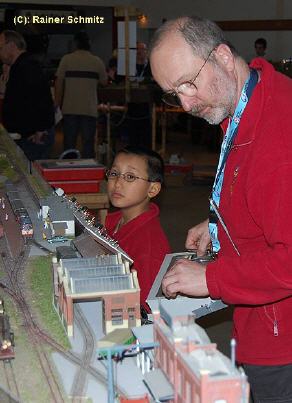
|
The apprentice driver of the WEK with the Profi-Control Panel during the Schmalspur-Session (Narrow Gauge Session).
The panel is designed for table top operation, which only makes sense with stationary layouts.
With large modular layouts, where loco crews follow their trains along the line from one LocoNet plug to another, a mobile version of the - simiilar to an original loco controls - panel is required.
You will now find a description of the modifications, that change the stationary panel into a mobile "hawker's tray".
|
|
|
Click on pictures to enlarge!
|
The supporting frame attached to the Profi-Control.
At the upper ends of the vertical supports a carrier belt (e.g. from a camera) is attached via snap hooks.
|

|
|
|
|

|
To connect the carrying rack (however remaining detachable) to the casing of the Profi-Control, the plastic casing should be reinforced with rigid anchor points.
The picture shows one of the attachment points for the carrying rack which have been integrated on both sides.
|
|
|
|
|
After removing the rubber studs at the bottom of the casing the screws become accessible to open the case.
|

|
|
|
|

|
A reinforcment made of 3 x 20 mm aluminium bar, which takes a M4 thread, is being attached with blind rivetting to the inside of the plastic casing.
|
|
|
Click on pictures to enlarge!
|
The heads of the blind rivets act as levelling of the recessed surface of the casing.
This allows the aluminium angle section to fit parallel against the casing.
|

|
|
|
|

|
One of the two parts of the carrier rack.
It was made from angle section 25 x 25 mm,
200 mm long, for the horizontal parts
and flat material 6 x 20 mm for the vertical supports.
In the vertical parts there is a M4-thread to stow away the wing screws when the rack is dismantled for transport.
|
|
|
|
|
The rigid connection of the aluminium profiles has been constructed by bending of flaps, and then blind rivetting the flat meterial between them.
|

|
|
|
|

|
One side of the carrier rack attached to the Profi-Control with the help of a wing screw.
The length of the angle section can be modified according to the abdominal girth (!) of the driver, to allow a convenient operation of the control panel under any circumstances.
|
|
|
Click on pictures to enlarge!
|
The two parts of the carrier rack attached to the Profi-Control viewed from underneath.
To allow space for the rubber studs of the control panel, holes had to be drilled into the angle sections.
|

|
|
|
|

|
The WEK train crew with attached Profi-Control on duty.
The height of the device can be modified by the adjustable carrier belt.
|
|
|
|
|
Top of page
|
Homepage - English
|

